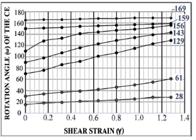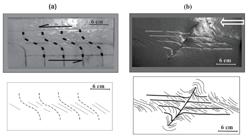ABSTRACT
The aim of this study is to present analog models of flanking structures and to analyze the Fábrica Nova synform, Quadrilátero Ferrífero, Minas Gerais, from a geometric point of view. We set up seven models using a linear viscous silicone and produced flanking structures with a shear velocity of 2 cm h-1. At different initial orientations with respect to the shear zone boundary, a rigid cross-cutting element with lubricated boundaries was deformed via sinistral bulk flow at a shear strain of γ = 1.28. The most interesting features of our experiments are the geometries of the different marker lines, which are heterogeneous and resulted from thickening and thinning of the silicone at the cross-cutting element terminations. To compare our analog models and the Fábrica Nova synform, we analyzed the outermost marker line of the analog models and the top surface of the Cauê Formation in the Paleoproterozoic metasediments. The best comparisons between the experiments and the natural example were obtained by our CIS90 model in terms of the flexure shape near the cross-cutting element and the cross-cutting element orientation. Thus, we suggest that the cross-cutting elements in both situations act as obstacles and consequently produce local perturbations in laminar flow.
Key words:
physical modelling; flanking folds; silicone; Fábrica Nova synform

 Thumbnail
Thumbnail
 Thumbnail
Thumbnail
 Thumbnail
Thumbnail
 Thumbnail
Thumbnail
 Thumbnail
Thumbnail
 Thumbnail
Thumbnail
 Thumbnail
Thumbnail
 Thumbnail
Thumbnail
 Thumbnail
Thumbnail








